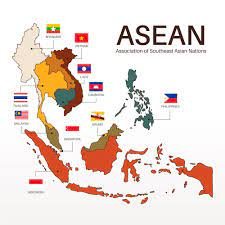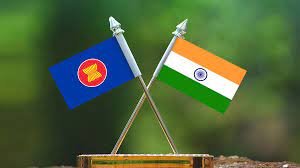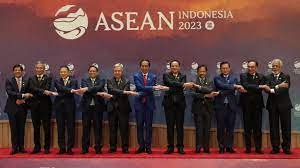
In a monumental development echoing through the vast corridors of international trade, India and the ASEAN bloc are on the precipice of engaging in pivotal negotiations to meticulously reevaluate their decade-old free trade agreement (FTA). The scheduled talks, poised to commence in the early throes of 2024, mark an epochal juncture in the economic collaborations between the Indian subcontinent and the tenacious ten-member Association of Southeast Asian Nations (ASEAN).
Navigating the Historical Mosaic of the ASEAN Pact
Fifteen years hence, the ASEAN-India Free Trade Agreement officially dubbed the ASEAN-India Trade in Goods Agreement (AITGA), was forged with the prime objective of cultivating a smoother tapestry of trade relations between the two entwined regions. However, as the economic topographies of both India and the ASEAN nations have undergone a metamorphosis, the imperative to recalibrate this foundational agreement has surged to the forefront. The slated negotiations for the early days of 2024 embark on a journey to scrutinize, recalibrate, and modernize the existing pact, ensuring its resonance with the ever-evolving economic dynamics.
The Catalyst Unveiled:
The decision to plunge into the labyrinth of renegotiation comes against the backdrop of a shifting global economic tableau. India, a pivotal actor in the international trade arena, has articulated concerns over the prevailing asymmetry within the trade agreement. Acknowledging the imperative to redress this imbalance, India has adopted a proactive stance, heralding a comprehensive review of the pact. The negotiation process, envisaged as a meticulous and collaborative endeavor, stands testament to the gravity with which both India and ASEAN approach the impending deliberations.
Charting the Course of Negotiations:
The overarching goal that looms over the renegotiation process is crystalline: to modernize the existing trade pact. At the forefront of the objectives lies the imperative to rectify trade imbalances that have burgeoned over the years. By dismantling barriers to trade and precluding the misappropriation of the agreement, the negotiators aspire to engender a more equitable and mutually enriching trade environment.
A Symphony of Structured Negotiation:

To facilitate a holistic review, both India and ASEAN have subscribed to a structured negotiation timeline. The quarterly negotiation regimen is meticulously crafted to ensure recurrent and substantive deliberations, affording a meticulous examination of every facet of the existing pact. The commitment to a multi-year timeline, eyeing completion by the denouement of 2025, underscores the labyrinthine nature of the negotiations and the unwavering dedication of both parties to sculpting a modernized and mutually beneficial trade agreement.
Harmony in Quarterly Negotiation Tempo:
The decision to embrace a quarterly negotiation tempo adds a stratum of structure to the labyrinthine process. This approach safeguards against haste, allowing for a nuanced exploration of each element within the pact. The quarterly checkpoints present an opportunity for both parties to evaluate progress, confront challenges, and recalibrate strategies if exigencies dictate. This methodical approach underscores the gravitas with which India and ASEAN approach the renegotiation process.
Rectifying the Equilibrium:
A pivotal focus of the negotiations is the identification and rectification of trade imbalances. This necessitates a scrupulous examination of trade flows between India and the member nations of ASEAN. By addressing these imbalances, the renegotiated pact aspires to craft a more even playing field, nurturing sustainable and balanced economic growth for all stakeholders.
India’s Proactive Overture:
India’s proactive approach to soliciting a review of the existing agreement manifests a commitment to fostering fair and mutually enriching trade relations. This stance aligns with India’s overarching economic strategy, which highlights collaboration and openness in the global marketplace. As negotiations unfurl, India’s role as a principal architect of the agreement will be scrutinized, with its approach poised to shape the trajectory of the renegotiation process.
Global Ramifications:
Beyond the regional reverberations, the renegotiation of the India-ASEAN FTA reverberates on the global stage. In an era of evolving trade dynamics and geopolitical tectonics, a fortified and modernized FTA between India and ASEAN could emerge as a paragon for other regions. The international community watches with rapt attention, acknowledging the potential for a reinvigorated and robust trade relationship that transcends borders.
Navigating Challenges, Embracing Opportunities:
As with any negotiation of such magnitude, challenges and opportunities intermingle in the intricate dance of diplomacy. The renegotiation process serves as a platform for both India and ASEAN to confront longstanding challenges, from tariff conundrums to non-tariff barriers. Simultaneously, it presents fertile ground to explore new avenues of collaboration, including nascent sectors, digital trade, and sustainable practices. The negotiations will invariably demand a delicate equilibrium, navigating complexities while harnessing the potential for innovation and growth.
Denouement:

The imminent negotiations between India and ASEAN to reassess their decade-old free trade agreement encapsulate a seminal chapter in the economic histories of both regions. As the negotiators delve into the intricacies of the pact, the world watches with bated breath. The gravity with which both India and ASEAN approach these talks underscores the imperative of recalibrating trade agreements to harmonize with contemporary economic realities. The denouement of these negotiations has the potential to delineate the economic landscape of the Indian subcontinent and ASEAN nations, setting the stage for a renaissance of collaboration and shared prosperity.










